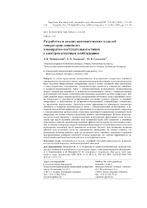| dc.contributor.author | Менжинский, А. Б. | ru |
| dc.contributor.author | Малашин, А. Н. | ru |
| dc.contributor.author | Суходолов, Ю. В. | ru |
| dc.coverage.spatial | Минск | ru |
| dc.date.accessioned | 2018-04-06T11:26:08Z | |
| dc.date.available | 2018-04-06T11:26:08Z | |
| dc.date.issued | 2018 | |
| dc.identifier.citation | Менжинский, А. Б. Разработка и анализ математических моделей генераторов линейного и возвратно-поступательного типов с электромагнитным возбуждением = Developing and the Analysis of Mathematical Models of Generators of Linear and Reciprocating Types with Electromagnetic Excitation / А. Б. Менжинский, А. Н. Малашин, Ю. В. Суходолов // Энергетика. Известия высших учебных заведений и энергетических объединений СНГ. - 2018. - № 2. - С. 118-128. | ru |
| dc.identifier.uri | https://rep.bntu.by/handle/data/40070 | |
| dc.description.abstract | В статье представлено математическое моделирование генераторов линейного и возвратно-поступательного типов с электромагнитным возбуждением, в результате которого были получены эквивалентные электрические схемы и схемы магнитной цепи генераторов, а также выражения, описывающие электромагнитные процессы в генераторах линейного и возвратно-поступательного типов с электромагнитным возбуждением. Математические модели генераторов линейного и возвратно-поступательного типов с электромагнитным возбуждением учитывают геометрические параметры магнитной системы генераторов, действие реакции якоря, неравномерность распределения магнитного поля в магнитной системе генераторов и зависимость коэффициентов рассеяния, краевого эффекта (в линейных генераторах) и выпучивания (в возвратно-поступательных электрических генераторах) от координаты перемещения. Проведена оценка эффективности применения генераторов линейного и возвратно-поступательного типов с электромагнитным возбуждением, в результате которой было выявлено, что эффективность возвратно-поступательного генератора с электромагнитным возбуждением ограничена величиной перемещения подвижной части генератора, что можно отнести к недостатку данного типа генераторов. Поэтому возвратно-поступательный генератор с электромагнитным возбуждением эффективней всего использовать при малой величине рабочего хода подвижной части либо совместно с линейным генератором в качестве компенсатора торцевого эффекта при возвратно-поступательном движении. В линейном генераторе скорость изменения индуктивности и взаимоиндуктивности на всем перемещении подвижной части практически постоянна. Поэтому при увеличении величины рабочего хода подвижной части его преимущества неоспоримы. Но следует отметить, что уменьшение величины рабочего хода для подвижной части линейного генератора ограничено конструктивными размерами магнитной системы генератора, что снижает эффективность его использования при малой величине рабочего хода подвижной части. | ru |
| dc.language.iso | ru | ru |
| dc.publisher | БНТУ | ru |
| dc.subject | Mathematical model | en |
| dc.subject | Linear electric generator | en |
| dc.subject | Reciprocating generator | en |
| dc.subject | Free-piston engine | en |
| dc.subject | Математическая модель | ru |
| dc.subject | Линейный электрический генератор | ru |
| dc.subject | Возвратно-поступательный генератор | ru |
| dc.subject | Свободнопоршневой двигатель | ru |
| dc.title | Разработка и анализ математических моделей генераторов линейного и возвратно-поступательного типов с электромагнитным возбуждением | ru |
| dc.title.alternative | Developing and the Analysis of Mathematical Models of Generators of Linear and Reciprocating Types with Electromagnetic Excitation | en |
| dc.type | Article | ru |
| dc.identifier.doi | 10.21122/1029-7448-2018-61-2-118-128 | |
| local.description.annotation | The mathematical modeling of generators of linear and reciprocating types with electromagnetic excitation resulted in obtaining the equivalent electrical circuit and diagrams of magnetic circuit of generators as well as the expressions that describe the electromagnetic processes in generators of linear and reciprocating types with electromagnetic excitation is presented in the article. Mathematical models of generators of linear and reciprocating types with electromagnetic excitation take into account the geometrical parameters of the magnetic system of generators, effect of the armature reaction, the unequal distribution of the magnetic field in the magnetic system of the generators and the dependence of the scattering coefficient and the fringe effect (in linear generators) and buckling (in the reciprocating electric generators) on the coordinates of the movement. An evaluation of the effectiveness of the generators of linear and reciprocating types with electromagnetic excitation was performed that demonstrated that the efficiency of the reciprocating generator with electromagnetic excitation is limited to the amount of movement of the moving part of the generator that can be considered as a drawback of this type of generators. Therefore, the reciprocating generator with electromagnetic excitation is more effectiv e to be used in a small value of the working stroke of the movable part of it or in conjunction with a linear generator as a compensator of the end effect in reciprocating motion. In the linear generator the rate of change of inductance and mutual inductance throughout the movement of the moving part is practically constant. So if an increase of the magnitude of the working stroke of the movable part takes place the benefits of the linear generator are undeniable. However, it should be noted that a reduction of the stroke magnitude of the movable part of the linear generator is limited by constructional dimensions of the magnetic system of the generator, which reduces its efficiency at low value of the working stroke of the movable part. | en |

